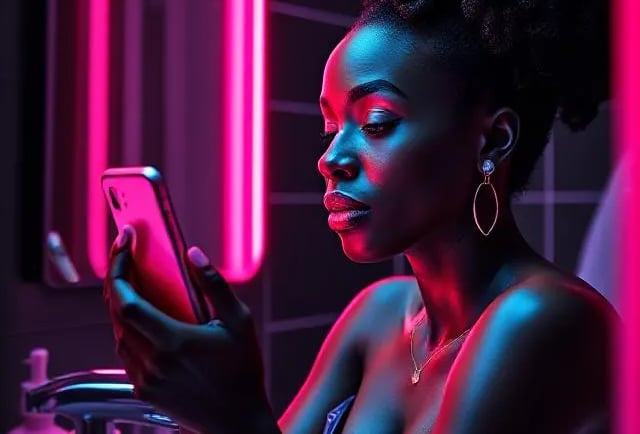Building the Future of Beauty Tech: My Journey through the AWS Developer course to Startup Dreams
SheGlow Concierge is an AI-powered skincare routine optimizer designed to deliver personalized daily skincare plans to users. The application intelligently analyzes user profiles (skin type, concerns, lifestyle, and goals) and generates tailored product recommendations using generative AI.
7/31/20254 min read
Three months ago, I was in front of my bathroom mirror, tired of another unsuccessful skincare regimen. Ring a bell? The moment of exasperation was my eureka moment — what if tech could solve this age-old issue we all have with skincare?
Fast forward to now, and that frustration is being turned into something constructive. I’m throwing myself into the AWS Developer Associate course, but here’s the interesting part: instead of simply finishing the typical bootcamp capstone project, I’ve determined that I’m going to work on building something that is meaningful to me — and maybe to the millions of others trying to find their footing in the bewildering landscape of skincare.
Why Beauty Tech Won My Heart
I’m guilty — I’ve always been that individual who gets really enthused about the confluence of tech and everyday challenges. There’s magic in all of us, applying the power of AI and cloud computing to real human problems, particularly in beauty and wellness. We are in a time when we’re able to stream films in a second and have food dropped to the door with the touch of a button, but for some reason, deciding on the correct skincare regimen is like dart-throwing blindfolded.
The beauty industry is ripe for disruption, and the technology to make meaningful change finally exists. Amazon Web Services provides the infrastructure, AI models like those available through Amazon Bedrock offer the intelligence, and the growing awareness around personalized wellness creates the perfect storm for innovation.
Introducing SheGlow Concierge: My Tech Love Letter to Beauty
The ultimate expression of my capstone project, the “SheGlow Concierge,” embodies all that excites me in a singular, bold venture. Just imagine having your own, personal skincare strategist. This machine-learned system not only makes recommendations, but crafts sustainable, custom routines that are tailored to your lifestyle, wallet, and skin aspirations.
The tech architecture takes advantage of the entire AWS toolkit: serverless computing with Lambda functions, seamless integrations with API Gateway, blazing fast data storage in DynamoDB, and Amazon Bedrock for the AI sorcery that enables personalized recommendations. But beyond the tech stack, I’m adopting modern DevOps practices with automated CI/CD pipelines and MLOps workflows that make the system continuously learn and improve.
Why is this different from other beauty apps already out there? Context and consistency. Rather than bombarding consumers with seemingly endless product suggestions, SheGlow Concierge is all about establishing routines individuals follow, monitoring progress months down the road, and adjusting recommendations based on actual results and unfolding life situations.
The Roadmap: From Idea to Concrete Outcome
Week 1 has been all about setting the foundations, getting the GitHub repository set up, installing the SAM (Serverless Application Model) template, and setting up the all-important CI/CD pipeline. It may not be sexy, but the groundwork here is the difference between a hobby app and a scalable, production-ready app. Each line of infrastructure code that I write now will save me hours of debugging later.
Week 2 is the most exciting part. We will be combining AWS Lambda functions with API Gateway, crafting the underlying backend that will later drive intelligent skincare recommendations. This is when the project moves from being abstract code to being accessible for user interactions.
The kicker in my pitch, however, is that SheGLOW Concierge is not the only project. I’m working simultaneously on a related beauty tech project, and the ultimate goal here is to develop an integrated intelligent beauty management ecosystem. I plan to nurture these concepts into a cohesive platform and pitch them to investors within the year.
Some might call it ambitious. I call it necessary. The beauty tech space needs solutions built by people who understand both the technical complexities and the real human needs behind them.
The Bigger Picture: Certifications, Community, and Career Growth
I will be chronicling the whole process here on Medium and presenting live updates on my portfolio site. It’s half accountability system, half learning machine, and half community building — because the most significant innovations come when we collaborate, share our learnings, and learn from one another.
I’m also competing against my deadline to obtain my remaining AWS certifications this year. Each certification is not only a credential, but confirmation that I possess the technical expertise necessary to develop enterprise-level solutions in the cloud. When I finally go to pitch these beauty tech ideas to venture capitalists, I want them to know that they’re not investing in good ideas, but in someone with demonstrated technical prowess.
What’s Next
The confluence of beauty, tech, and startups has never been more thrilling. We’re in an era when technology is advanced enough to deliver beneficial personalization, cloud infrastructure is low-cost enough for individual developers to develop scalable applications, and consumers are primed for products that deliver.
I’m sharing this journey publicly because innovation happens best in community. Whether you are a developer interested in AWS implementations, someone who loves beauty tech, or an entrepreneur in related fields, I would love to connect and learn from your experiences..
Stay tuned for updates as I navigate the challenges of building a real product, the lessons learned from implementing AWS services in production, and the occasional breakthrough moments that make all the late-night coding sessions worthwhile. The beauty tech of the future is not better products, but better systems that learn and adapt to fundamental human needs. And that’s the future that I’m building, function by function.

